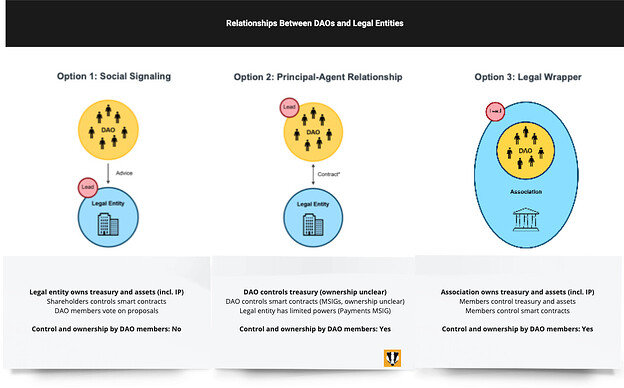TLDR; Outlines relationship between BadgerDAO and its supporting legal entity, the Badger Association
- BadgerDAO is governed by token holders
- BadgerDAO controls the treasury, per the Treasury Management Policy
- BadgerDAO is the principal and the Association is a supporting agent, they are independent, separate bodies of one another
- The Association is financed by the treasury and thus by BadgerDAO
What is the Badger Association?
The Badger Association is a Swiss entity and has its registered office in Zug, Switzerland.
The bodies of the Association are:
- General assembly of members
- The board of directors: @spadaboom, @dapp-whisperer and @lipp
What’s the Association’s Purpose?
The purpose of the Association is to foster growth of the BadgerDAO ecosystem; to enable technical and operational development by hiring and managing contractors, to progress strategy, partnerships, and to help evolve legal, security, and overall best practices in supporting BadgerDAO.
How was the Association created?
The Treasury Policy was approved by token holders. (BIP 89 - approved on April 29th, 2022)
The Treasury Council approved funding for the Association, and it’s been operating effectively for a year.
The core contractors have responsibility for daily operations, including work related to legal, regulatory, and overall safety, as outlined here: (BIP 93 - approved June 30th, 2022)
Treasury Council decisions, Badger Council decisions, DAO multisigs, transactions, and financials are all public.
Why is the Association an asset?
Accelerating global market access enables BadgerDAO to interact with the offchain world and complete due diligence to enable commercial partnerships. The Association also protects liability within these relationships.
A legal entity such as the Association is useful for the BadgerDAO in many ways. A legal entity not only facilitates invoicing and VAT collection for service providers, but can also own the deliverables created by service providers, and make them available to the general public under a permissive open source license.
Throughout 2023, the Association has fostered relationships to support the growth of the BadgerDAO ecosystem with 36 supporting providers. This work has enabled support for development, security, financial, legal and commercial innovation and to help daily operations of the DAO. The Association currently maintains contractual relationship with:
- 20 service providers
- 10 full time contractors; core development and operations
- 6 part time advisory contractors
These are contracted providers with obligations to the Association with board oversight for quality and safety. Here’s examples of the service providers that have been engaged with the Association:
What’s the relationship between the DAO and the Association?
The objective has always been to keep ownership and control of the DAO with the token holders. This objective has been maintained with the Association structure, which is consistent with how BadgerDAO has always worked.
The Association folds into the Treasury Policy and Governance 2.0 BIPs.
Key highlights of the chosen structure:
- DAO controls treasury (ownership unclear)
- DAO controls smart contracts (via MSIGs, ownership unclear)
- The Association has limited powers (just the Payments MSIG) and can only spend the funds it receives from the treasury
Here’s a summary of the possible relationship archetypes between DAO’s and legal entities.
The relationship between BadgerDAO and the Association is a prime example of the Principal-Agent model (Option 2). In this model, the legal entity is an independent service provider that is engaged by the DAO to act on its behalf and promote the growth of the ecosystem. The legal entity co-exists with the DAO and does not act as a “legal wrapper”. This means that the legal entity does not protect the DAO and its members from potential liability. On the other hand, this model ensures that the control remains with the DAO.
The establishment and funding of the Association aligns with the Principal-Agent model, as the BadgerDAO decides what powers the Association shall have. The treasury and the supporting Treasury Council remain independent from the Association at all times. The BadgerDAO retains control of the treasury and decentralized MSIGs, except the Payments MSIG, which is used to pay the individual service providers engaged by the Association.
What’s the benefit of being a Swiss Association?
Contributors worked with legal counsel to select a jurisdiction for the entity. Switzerland objectively won the global jurisdiction analysis, as it is a crypto-friendly, neutral and sovereign jurisdiction with clear guidelines from its financial market authorities (FINMA) on crypto, offers a favorable tax regime, and a crypto-friendly banking industry.
The Swiss association (among all available entity types) was chosen for the following reasons:
- The Swiss association has rights of personhood and can therefore hold assets, funds, enter into contracts (for example with developers) just like an LLC or foundation.
- The Swiss association provides liability protection to the association members and board members, as only the association’s assets are used to meet liabilities.
- The Swiss association is a flexible vehicle. The organization as well as the purpose of an association can evolve. The Swiss association is easily established and dissolved or moved if needed.
- The Swiss association is not allowed to provide any financial benefits to its members, which means that the association cannot distribute any funds to its members in the form of dividends or other benefits.
